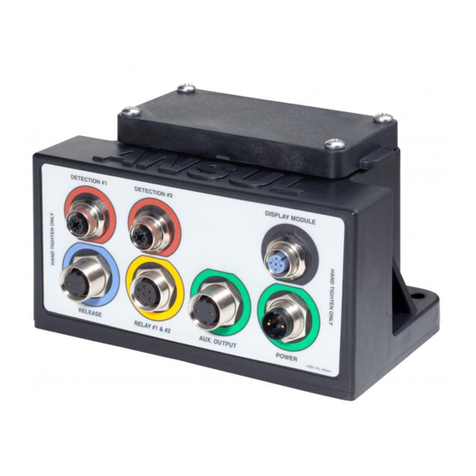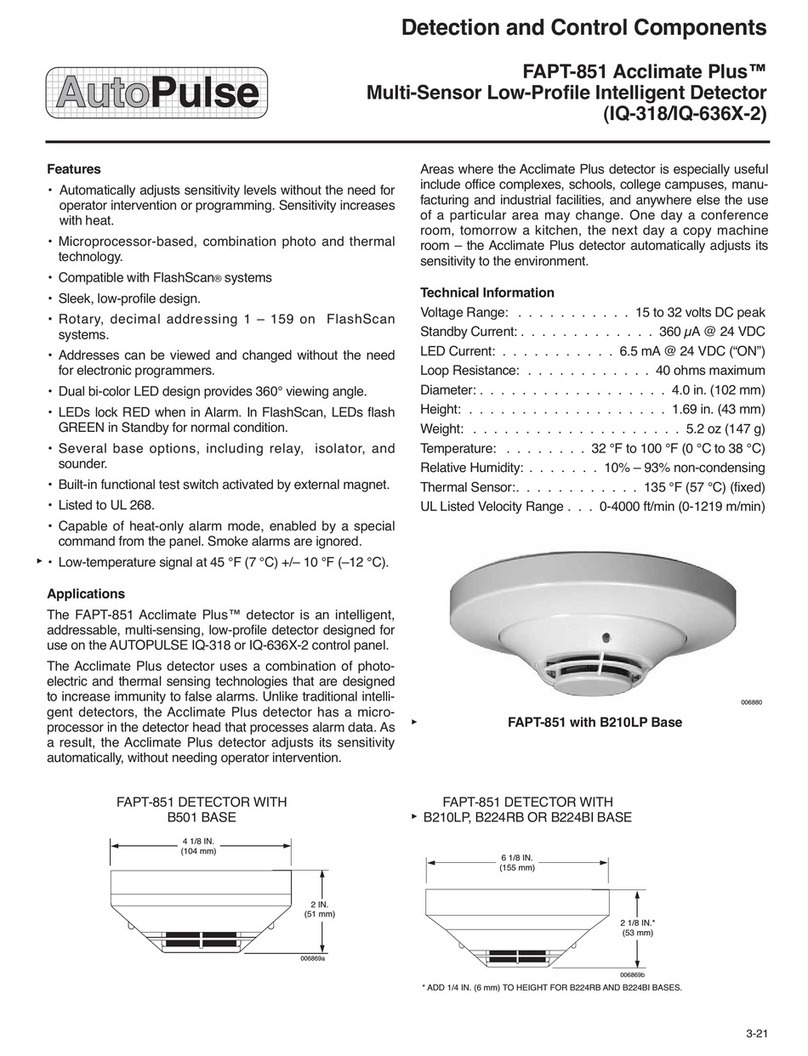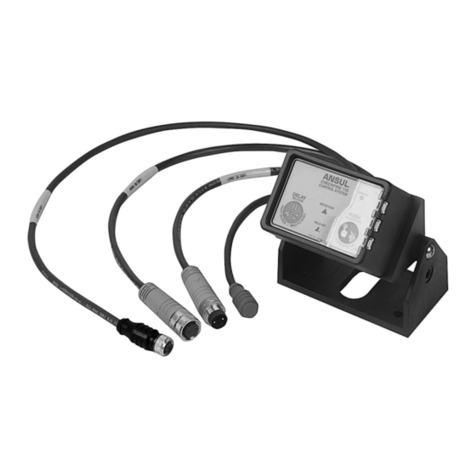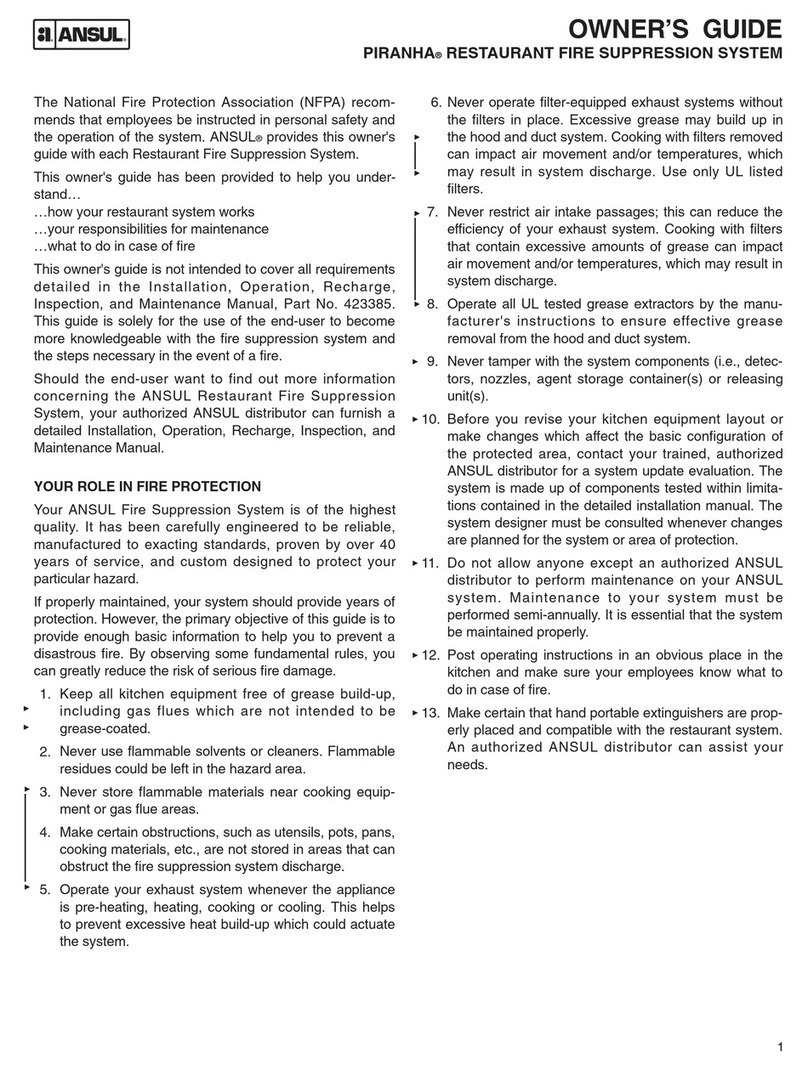
TECHNICAL FEATURES
7-1-07 Page 2
REV. 2
1 TECHNICAL FEATURES
• DETECTION RANGE: up to 33.0 ft (10 m) for a 1 ft2(0.1 m2)fire.
• ULTRA HIGH IMMUNITY TO FALSE ALARMS: (see para. 2.3).
• ADVANCED DIGITAL PROCESSING OF THE DYNAMIC CHARACTERISTICS OF FIRE: Flickering, Threshold correlation and
Ratio.
•THREE SEPARATE IR CHANNELS: Between 3-5 microns.
• TWO RESPONSE LEVELS: Warning & Detection.
• SOLAR BLIND
• MICROPROCESSOR BASED: Digital signal processing.
• BUILT IN TEST: Manual BIT
• CERTIFICATION: FM Approved with CHECKFIRE SC-N Electric Detection and Actuation System
1.1 PRINCIPLES OF OPERATION
1.1.1 Hydrocarbon fire detection
The triple IR flame detector detects all conceivable types of hydrocarbon fires, i.e. any fire, which emits CO2.
1.1.2 Identifying the CO2peak
The hydrocarbon fire is characterized by a typical radiation emission. The CO2peak emits intense radiation in the spectral
band between 4.2 µ – 4.5 µ and weaker radiation intensity outside this spectral band.
1.1.3 The limitations of IR-IR flame detectors
CO2in the atmosphere attenuates the radiation in this spectral band. (Absorption and emission of radiation always occur in
the same band.) As a result, the greater the distance between the detector and the fire, the weaker the intensity of the radia-
tion reaching the detector (the CO2attenuation increases). This phenomenon explains the limitations of the existing IR-IR
flame detectors in the market:
• Detection distance is restricted to 10 meters (33 ft) only.
• Their immunity to false alarm sources is limited.
1.1.4 The advantages of IR3technology
IR3technology overcomes these limitations by an innovative concept of utilizing an additional detection channel. Three chan-
nels collect more data from the environment, permitting more accurate analysis and better performance. After careful investi-
gation, three channels were selected which, when operating jointly,provide optimal fire detection characteristics:
Channel 1: 4.2 µ – 4.6 µ
Fire – the CO2peak.
Channel 2: 4.0 µ – 4.2 µ
Eliminates false alarms from high temperature sources.
Channel 3: 4.8 µ – 5.2 µ
Eliminates false alarms from flickering of background radiation.
Most IR sources, which create misleading IR alarm stimuli, including the sun, incandescent and halogen lamps, electric arc
discharges, electrical heaters, etc., do not possess this unique spectral signature of fire. The IR sensors of the detector
respond only to flickering of radiation signals. The signals are compared to a predetermined threshold. Processing of the
results from the three IR channels is performed by the board microprocessor.The result is a much greater detection distance
and a highly increased ability to distinguish between fire and false alarms. This sophisticated technology surpasses all other
existing flame detection techniques on the market today. Further enhancement of this triple IR analysis enables the accurate
detection of a hidden or smoldering fire where the radiating flames are not visible, but the emitted hot mass of CO2gases is
detected.
This unique flame analysis capability (patent pending) has been incorporated into the Triple IR fire detector.The
result is a unique flame detector, which does not produce false alarms and provides at the same time detection over
greatly increased distances.
1.1.5 Model
The model, 20/20MI-32-S-F, is a short range, fast detection type with a range up to 33.0 ft (10 m).
The 20/20MI-32-S-F has a stainless steel housing.































